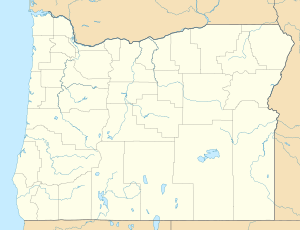Nestucca River facts for kids
Quick facts for kids Nestucca River |
|
|---|---|

Nestucca River in the Coast Range
|
|
|
Location of the mouth of the Nestucca River in Oregon
|
|
| Country | United States |
| State | Oregon |
| County | Tillamook |
| Physical characteristics | |
| Main source | Central Oregon Coast Range near Ball Bearing Hill, Tillamook County, Oregon 2,249 ft (685 m) 45°16′23″N 123°23′33″W / 45.27306°N 123.39250°W |
| River mouth | Nestucca Bay near Pacific City, Tillamook County, Oregon 0 ft (0 m) 45°11′03″N 123°57′26″W / 45.18417°N 123.95722°W |
| Length | 57 mi (92 km) |
| Basin features | |
| Basin size | 255 sq mi (660 km2) |
The Nestucca River is a river in northwest Oregon, USA. It flows for about 57 miles (92 km) through forests near the Pacific coast. The river helps drain a timber-producing area of the Northern Oregon Coast Range west of Portland.
The river starts in the mountains of western Yamhill County. Near its beginning, a dam creates McGuire Reservoir. This reservoir is the main water source for the city of McMinnville. The Nestucca River generally flows west through public lands like those managed by the Bureau of Land Management (BLM) and the Siuslaw National Forest. It passes by towns such as Beaver, Hebo, and Cloverdale. Finally, it flows into Nestucca Bay near Pacific City, which opens into the Pacific Ocean. The Little Nestucca River also flows into Nestucca Bay, but it does not join the main Nestucca River.
Contents
Fun on the Nestucca River
The Nestucca River is known as a great place for outdoor activities. Many people enjoy fishing and boating here.
Fishing for Salmon and Trout
Anglers (people who fish) love the Nestucca River. You can find several types of fish here. These include spring and fall chinook salmon, coho salmon, coastal cutthroat trout, and steelhead.
- Winter Steelhead: These fish often weigh between 10 to 14 pounds (4.5 to 6.4 kg).
- Summer Steelhead: These are smaller, usually 4 to 7 pounds (1.8 to 3.2 kg). Sometimes, you can see many of them in a 20-mile (32 km) section of the river.
Boating and River Access
It can be tricky to reach the lower parts of the river from the bank because much of the land is privately owned. However, the lower river is wide, about 50 to 100 feet (15 to 30 meters), so it's often fished from boats.
There are public boat ramps in:
- Cloverdale
- Farmer Creek
- Three Rivers
- Pacific City
You can also find other, less formal places to put boats in further upriver.
Camping Along the River
Upstream from Moon Creek, more than half of the land along the river is public. This land is managed by the Siuslaw National Forest and the BLM. There are five campgrounds in this area where you can stay. The upper part of the river, between Moon Creek and Elk Creek, is mainly used for winter steelhead fishing. Fishing is not allowed upstream of Elk Creek.
Whitewater Adventures
If you enjoy exciting water sports, an 8-mile (13 km) section of the upper river is great for whitewater canoeing and kayaking. This is best when the water flow is around 1,000 cubic feet per second (28 m³/s).
- Challenging Rapids: The first 2 miles (3.2 km) of this section have some tough rapids. There's a Class 4 rapid, then a Class 5, and another Class 4.
- Easier Sections: If you prefer less intense whitewater, you can start at a log bridge downstream of the second Class 4 rapid. From there, the remaining 6 miles (9.7 km) of the run have Class 2 and 3 whitewater, which is still fun but a bit easier.



